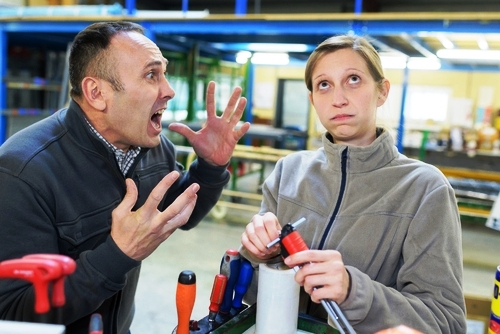
No workshop owner or manager wants to see a sight like the one in the image above; a workshop full of cars and nobody working on them. Of course, there may be a legitimate reason why there is no activity- everybody may be on his or her lunch break or the workday may not have begun. Whatever the reason though, how quickly the vehicles in this image get fixed depends on two things, these being the productivity of each individual technician, and the efficiency of the front office staff, whose secondary function is to provide logistical support to the technical staff. However, things are not always as simple and clear-cut, and in this article, we will take a closer look at the differences between the concepts of efficiency and productivity as they apply to the car repair trade, starting with this question-

Conventional wisdom has it that efficiency refers to how quickly a task can be performed using the least amount of resources, while productivity refers to how many of those tasks can be performed within a given time period. While these definitions are fairly accurate, they are also simplistic, and therefore, they will only actually work in a perfect world where the workflow cannot be interrupted by any number of possible variables.
As workshop owners/managers, we have all had to deal with factors that interrupt our daily business. Delays in parts deliveries, parts unavailability, additional /unforeseen work required to complete a repair, walk-in customers with (possibly genuine) urgent issues, and even technicians missing work due to illness, annual leave, or personal issues all play a role in the overall efficiency of our workshops; the list is almost endless, and need not be elaborated upon further.
Thus, from a practical point of view, we can only work with what we have on a given day, but what we should always guard against is viewing productivity and efficiency as two separate issues. The fact is that the two terms are two sides of the same coin, which means that you cannot have one without the other, and the trick to using the coin effectively involves knowing which side of the coin to apply to which part of our business.
Let us use the classical approach to calculating productivity, which business school textbooks tell us is a fairly simple affair. In this calculation, you determine the total number of working hours in day/week, and then multiply that value by the number of employees (technicians in this case). Thus, if you have 8 technicians each working 8 hours a day (excluding breaks), 5 days a week, you have 320 “billable” hours in a regular 5-day work week.
We know that most technicians do this on a daily basis, which means that our technicians are generally about 100% productive, but this is not an indication of how efficient they are. Let us use a practical example; say a brake pad replacement takes one technician exactly 1 hour to complete, while another needs 1.5 hours to complete the same task on the same vehicle. Both technicians are 100% productive since they are working continuously, but the second technician is only half as efficient as the first because he takes 50% more time to complete the same task, assuming that neither technician had to perform additional work (such as freeing a sticky calliper) during their respective brake pad replacement jobs.
In the real world, (such as in our workshops) the above example can only be applied to the same jobs on the same or similar vehicles, which means that the more diverse the jobs we accept become, the more difficult it becomes to calculate or measure the efficiency of each individual technician. However, since a simple brake pad replacement can in no way be compared to a DSG clutch replacement, we can use the abilities and skill levels of our technicians to decide which side of our two-sided coin to apply to which technician, which brings us to-

While we would all like to employ technicians that are always as efficient as they are productive, we must accept that technicians are as diverse in terms of their training, skill level, and ability to both think logically and work under pressure, as the jobs and vehicles are that we accept on a daily basis. From a management perspective, this can make things very difficult at times, since profitability is directly related both to how efficient (as opposed to how productive) our technicians are, as well as how well (or otherwise) we as managers apply the skills of our technicians.
Here is another example. If we accept that all the technicians we employ are about 100% productive since they are all actively working throughout the day, we need to determine which technicians are best suited to complex tasks like advanced diagnostics, rebuilding engines, or replacing DSG clutches, and which ones are best suited to repetitive tasks like performing safety checks, doing routine services, or changing brake pads.
However, while doing the above analysis represents an interesting intellectual exercise, we need to take step back and consider a few things before we dive headlong into a process that could actually make things worse. What we need at this point are objective parameters to use as guidelines, without which it would be impossible to increase our workshop’s overall productivity, so let us start with this-
How long do jobs actually take?
If we asked 10 technicians how long it takes to perform “X” on vehicle “Y”, we will almost certainly not receive a definitive answer, much as we would have liked the answer to be a simple “Z” number of hours.
In this writer’s experience, this is not because technicians are inherently lazy or dishonest. It is because all experienced (and prudent) technicians can foresee any number of things going wrong during any given repair, and therefore build in a bit of extra time as a safety cushion, so how do we get around technicians padding estimated repair times with unreasonable safety cushions?
It’s simple, really. We analyse our work orders going back a few years, and calculate the average times it took to perform certain routine tasks. For instance, if we find that the average turn-around time on brake pad replacements is now 1 hour, whereas the recorded historical turn-around time for brake pad replacements was only 40 minutes, we are 33% less efficient than we used to be. However, despite this, we are still 100% productive, simply because our technicians are now working a full hour on a job that has come to take 1 hour to complete, as opposed to the 40 minutes it took to complete, say, 3 years ago.
There are many possible reasons why brake pad replacements now take an hour as opposed to the 40 minutes it took before. However, in this writer’s experience, the only way to resolve such a situation is to calculate an average (but reasonable) time each type of routine repair should take, and to indicate to the responsible technician (on the work order) how long you, as the owner or manager, expect him to spend on the job, whatever that job might be.
Doing things this way is the only reliable method to gather data on which to base efficiency and/or productivity calculations, or more succinctly, how not to confuse productivity with efficiency.
Who is to blame for decreases in efficiency?
The same test as above can be applied to all the jobs we do on a regular basis, but to be fair to technicians, reduced efficiencies are not always their fault. For instance, if a workshop used to have a dedicated hoist for brake and suspension jobs and that hoist is no longer working or available, it is obvious that brake and suspension jobs will take longer if technicians have to work in uncomfortable positions. In this case, reduced efficiencies are a management issue, which only management can resolve by replacing the hoist.
Similarly, switching to parts suppliers that are located further away means increased waiting times for parts, regardless of whether you collect spare parts yourself, or if suppliers deliver them to your door. Situations like this create idle time that affects both efficiency and productivity, so what we need to do is to evaluate and reassess the entire chain of events that occurs between the time a customer presents a vehicle to us, and the time a technician can actually start work on that vehicle.
This writer faced just such a situation when a major parts supplier that was located less than 200 metres away from his front door moved to a location more than 20 km away. Since the two small suppliers that remained in the vicinity were less than useless, maintaining efficiency and productivity demanded a complete rethink of how things were done, so here’s how things changed-
The first thing was notifying both existing and potential new customers that casual, walk-in jobs would no longer be accepted, and that making an appointment would henceforth be the only way we could fit their vehicles into our schedule. There was some initial resistance to this, but once the benefits of bookings-only work became clear to everybody, our vehicle count actually increased.
In this writer’s case, working by appointment only had two effects; the first was that the service writers now had the time to arrange for timely parts delivery so that the correct parts were available and ready at hand when the customer arrived, which eliminated the idle time technicians sometimes spent waiting for parts altogether.
The second thing that changed was the appointment of a diagnostician, whose only responsibility was to diagnose faults, and then to write a report on the fault or defect and what needed to be done to correct the issue. This report was handed to the service writers, who then passed it on to the responsible technician along with the work order and the previously ordered and delivered parts.
However, it soon became clear that walk-ins could not be avoided altogether, so the third thing that changed was the appointment of a “walk-in technician” who received the assistance of an apprentice. This person was a highly skilled and experienced technician whose primary task it was to look after walk-in customers, and when he had nothing to do, he was to help the diagnostician. An unintended, but happy consequence of this arrangement was that the apprentice who was assigned to the walk-in technician received huge chunks of advanced training in a very short time.
As a practical matter, this writer’s primary parts supplier moving away produced vastly more benefits than drawbacks. Rethinking the work process and making some key appointments greatly increased the efficiency of the entire technical staff compliment, which translated into a positive change in how customers experienced the repair process of their vehicles, which in turn, attracted even more business, thus increasing profitability.
Expecting 100% efficiency is unrealistic
The first lesson one should learn in the car repair trade is that chasing a perfect efficiency rate relative to productivity is a bit like chasing the wind and hoping to catch it. Just as it is unrealistic to chase and catch the wind, so is it unrealistic to chase a perfect efficiency score simply because people are not perfect. Since people are just not built to be perfect and the Law of Averages states that mistakes will occur every so often, this means that the best we as owners and managers of workshops can do is take decisive measures to mitigate the effects of mistakes, oversights, or poor planning.
However, this is not to say that we should not strive to be as efficient as we can be, but getting to that point can only happen if we take into account all the factors that have negative impacts on our efficiency and productivity, and then only the factors that apply to our particular circumstances. For instance, what affects efficiency and productivity in one workshop may not apply to another, and what works as remedial steps to fix issues in one workshop may not work in any other workshop.
Nonetheless, poor efficiency and low productivity have certain features that are common to all workshops, and while the causes of these features such as poor staff morale, a high staff turnover, a high comeback rate, and a poor reputation can have devastating effects on profitability, most of these issues can be fixed relatively painlessly and without great expense. Here are some practical steps you can take-
Train / retrain / replace service writers as required
While most service writers can be said to productive in the sense that they are at their posts every day, many service writers are extremely inefficient. For instance, a typical service writer’s job entails far more than taking a customer’s personal details, recording his or her concerns on a work order, and shifting the responsibility by passing on the work order to the workshop supervisor or responsible technician.
An efficient service writer on the other hand, will receive a customer, note his/her concerns, and perform a preliminary inspection of the vehicle noting tyre pressures, tyre condition, fluid leaks and their location, and the presence of strange smells. Moreover, an efficient service writer will also test drive the vehicle, and note his observations as they relate to the customer’s main concern(s), along other observations such as non-working lights and accessories that may or may not relate to the main concern(s).
The advantages of service writers doing all of the above include reduced road testing times, and in many cases, reduced diagnostic time because the road test may have revealed the root cause of the customer’s concern(s). More importantly though, an efficient service writer avoids misunderstandings and miscommunications between the customer, the workshop management and the responsible technician, who needs a clear and complete picture of what is wrong with a vehicle more than anybody else.
Implement definitive quality control measures
If you employ a workshop supervisor, make it that person’s job to perform definitive and objective inspections on all vehicles after repairs have been completed. Typically, such an inspection would involve verifying that all noted issues have been addressed and resolved. More importantly, this inspection will ensure that all warning lights are extinguished, that all codes relating to the requested repair have been cleared, that all readiness monitors have run and completed during a road test where this required, and that all required adaptations and/or supplementary procedures have been completed successfully.
The advantages of definitive quality control measures are that comebacks are greatly reduced, if not eliminated altogether, and that the technicians’ collective efficiency is raised to a level that outshines that of all your competitors- mainly because no technician likes to be shown up for his mistakes in front of his colleagues.
Acknowledge high standards of work
Nothing works as well to raise efficiency levels as acknowledging consistently high work standards. However, the performance of technicians and other staff members must be measured against objective, reasonable, and achievable standards that are the same for everyone. Acknowledgment can be in the form of an Employee of the Month scheme, or a small, but meaningful cash bonus, or even a barbeque in honour of the winner, but in all cases, the awards must be consistent, and resistant to manipulation of any kind.
Change your management style
The sad thing about bad managers is that no bad manager can see how bad he or she is at managing people. While it is not the intention of this writer to tell anyone how his or her workshop should be managed, the fact is that poor efficiency and productivity in a workshop is seldom the cause of anything other than bad management and/or poor people skills on the part of management. More to the point though, one other sad thing about bad managers is that since they generally don’t respond at all well to advice and criticism, it is no easy task for outsiders, employees, or even professional business consultants to fix productivity issues that result from bad management practices, and/or a lack of appropriate people skills.
Most people have the ability to do some introspection, so if you are struggling with low productivity and poor efficiency issues in your workshop but nothing seems to work to fix them, you may want to consider the possibility that more than anything else, your management style and approach to both the problem and your employees might be the problem.
As long-time workshop owners and managers, we know that running a busy workshop effectively and profitably is no easy task, and that not everyone is suited to it. However, the challenges we face and overcome every day are just that- challenges that can be overcome.
However, once we recognise that we do have a problem with efficiency and productivity, speedy remedial action is required, and while not everything in this article applies to all situations, or are too expensive to implement in some cases, assuming a laid-back attitude towards the root causes of the issues is the worst possible course of action we can possibly take. Speedy, decisive, and positive remedial actions usually deliver speedy and measurable positive results, but of course, in an ideal, if not perfect world, we would never have these kinds of issues, now would we?